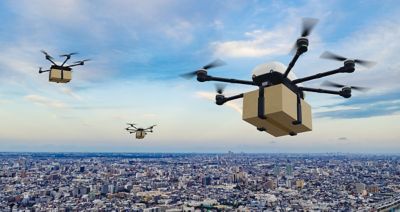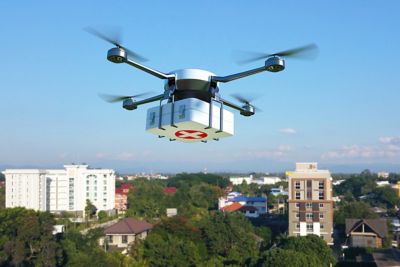-
United States -
United Kingdom -
India -
France -
Deutschland -
Italia -
日本 -
대한민국 -
中国 -
台灣
-
Ansys는 학생들에게 시뮬레이션 엔지니어링 소프트웨어를 무료로 제공함으로써 오늘날의 학생들의 성장을 지속적으로 지원하고 있습니다.
-
Ansys는 학생들에게 시뮬레이션 엔지니어링 소프트웨어를 무료로 제공함으로써 오늘날의 학생들의 성장을 지속적으로 지원하고 있습니다.
-
Ansys는 학생들에게 시뮬레이션 엔지니어링 소프트웨어를 무료로 제공함으로써 오늘날의 학생들의 성장을 지속적으로 지원하고 있습니다.
ANSYS BLOG
April 4, 2023
Drone Safety Takes Flight at Airbus, Supported by Ansys SCADE
The global market for unmanned aerial vehicles (UAVs) is growing rapidly, with sales of $26.2 billion in 2021 — a figure that’s projected to grow to $38.3 billion by 2027.1 Around the world, drones are being used in a range of applications that include defense, fire fighting, search and rescue, surveillance, meteorology, news and sports coverage, agriculture, and the delivery of everything from critical medical supplies to mail. UAVs can travel into dangerous situations or remote locations without putting human lives at risk.
Airbus, a presenter at the recent Ansys Digital Safety Conference (DSC) is a global leader in this industry, known for its product innovation in both defense and commercial drone applications.
Recently Airbus successfully demonstrated how unmanned and manned aircraft can work together during defense missions,2 paving the way for Europe’s Future Combat Air System. In the summer of 2022, the company’s solar-powered Zephyr drone broke world records when it stayed aloft for 64 days.3
While Airbus is clearly focused on redefining the industry via innovation, safety can never be compromised when launching new product designs. The company’s global product development team relies on the suite of Ansys SCADE solutions to ensure the safety of the embedded software code that underlies many of its UAV systems. By using SCADE’s model-based development environment, Airbus can make its software design and verification process as fast and productive as possible while still ensuring reliability in mission-critical applications.

Ground Control Stations: A Critical Component of UAVs
In her presentation at DSC, Cristina Rasilla Reymundo, a control station systems engineer at Airbus Defense and Space, described how Airbus is using SCADE to develop ground control stations for UAVs. Ground control stations are a combination of hardware and software that functions as an “on-ground cockpit” for the UAV.
With both monitoring and command capabilities, ground stations can gather, send, and receive information from an aircraft at critical moments such as launch, while also ensuring safe operation during sustained flights. How important are these components? The global market for ground control stations is projected to reach $850.5 million by 2027.4
In her DSC presentation, Rasilla described the three types of UAV control systems:
- Portable ground control stations — which could be a laptop or a tablet — allow fast, simple deployment.
- Mobile ground control stations provide line-of-sight communication with the UAV during flight.
- Distributed ground control stations, which have two parts: a mobile launch and recovery element that is used for line-of-sight communication during takeoff and landing and a fixed station that communicates with the UAV during its flight.
Product development efforts at Airbus focus on both mobile and distributed ground control stations.

Building in Reliability via Ansys SCADE
Human-machine interfaces (HMIs), supported by thousands of lines of software code, are essential to ensure that these components work effectively and are easy to use by operators. Airbus has invested significantly in developing a common HMI platform that serves as the foundation for all its ground control solutions. Starting in 2015, Airbus began using SCADE to develop the underlying software code for this HMI platform.
“In previous development projects, the HMI was fully developed with handwritten code. However, at some point we decided to evolve our HMI processes, and we decided to use Ansys SCADE for model-based system engineering,” says Rasilla. SCADE enables Airbus to generate code automatically while also linking to critical industry requirements to ensure compliance.
“We needed the HMI and its underlying code to be certifiable against a range of commercial and military standards,” says Rasilla. “We apply the standard ARINC 661, which defines an overall software architecture for interactive displays. It governs both the cockpit display system and the user application, including its foundational software and logic.”
Why does Airbus rely on SCADE for this mission-critical safety task? “First of all, the SCADE suite of solutions has been used in Airbus for commercial and military programs for a long time, with very good results. It is a proven solution,” says Rasilla. “Second, SCADE ensures compliance with ARINC 661 and other standards because those requirements are built into the solution. Third, SCADE is designed for interoperability with the other tools we’re using, so we get the maximum use and reuse of our data as we move from one program to another.
“Finally, SCADE was designed specifically to address software development for critical systems by experts who understand the process,” Rasilla emphasizes. “It’s a customized tool, so we are not forced to use manual processes and consumer-grade software to accomplish a very specialized, important task in our product development efforts.”
At Airbus, SCADE tools will help to significantly reduce safety certification time and costs by simplifying critical control application design, and by automating verification, qualifiable/certified code generation, and documentation generation. SCADE solutions integrate seamlessly into the product development flow at Airbus, thanks to their interoperability standards and Python-based customization capabilities.

Supporting a Higher Level of Product Innovation
SCADE also makes it easy for Airbus to reuse its previous models and data, instead of starting from scratch each time the software architecture is tweaked or updated. As changes are made in one area of the SCADE-created model, they are automatically reflected across the architecture. This not only saves time, but also enables engineers to innovate more freely.
As Airbus continues to lead the global UAV marketplace through its groundbreaking product innovations, the company can’t be constrained by handwriting code and managing regulatory compliance by using consumer-grade software. The SCADE family of solutions is purpose built to efficiently and automatically ensure compliance while driving innovation via a model-based, logical approach.
“From monitoring and controlling the UAV to managing the HMI and displays, our goal is to ensure that our product platform is verified for safe, reliable performance under actual operating conditions,” says Rasilla. “That gives Airbus, as well as our customers, a high level of confidence.”
Want to learn more about how Airbus is leveraging the capabilities of Ansys SCADE? Watch Cristina Rasilla Reymundo’s presentation at the 2022 Ansys Digital Safety Conference on demand here.
References
- “Global UAV Market Report 2022: Use of UAVs for Cargo Delivery in Military Operations Presents Opportunities.” PR Newswire, November 17, 2022.
- “Airbus Leads Large-Scale Manned-Unmanned Teaming Flight Demo.” Avionics International, December 13, 2022.
- “Up, up and away: Airbus’ Zephyr drone breaks flight record high above Arizona.” Defense News, July 22, 2022.
- “Global UAV Ground Control Station Market to Reach $850.5 Million by 2027.” Yahoo Finance, October 13, 2022.










